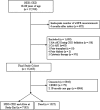GFR decline and mortality risk among patients with chronic kidney disease
- PMID: 21685022
- PMCID: PMC3359538
- DOI: 10.2215/CJN.00470111
GFR decline and mortality risk among patients with chronic kidney disease
Abstract
Background and objectives: Estimates of the effect of estimated GFR (eGFR) decline on mortality have focused on populations with normal kidney function, or have included limited information on factors previously shown to influence the risk of death among patients with CKD.
Design, setting, participants, & measurements: We retrospectively assessed the effect of rate of eGFR decline on survival of patients with CKD receiving primary care through a large integrated health care system in central Pennsylvania between January 1, 2004, and December 31, 2009.
Results: A total of 15,465 patients were followed for a median of 3.4 years. Median rates of eGFR change by those in the lower, middle, and upper tertiles of eGFR slope were -4.8, -0.6, and 3.5 ml/min per 1.73 m(2)/yr, respectively. In Cox proportional hazard modeling for time to death, adjusted for baseline proteinuria, changes in nutritional parameters, and episodes of acute kidney injury during follow-up (among other covariates), the hazard ratio for those in the lower (declining) and upper (increasing) eGFR tertiles (relative to the middle, or stable, tertile) was 1.84 and 1.42, respectively. Longitudinal changes in nutritional status as well as episodes of acute kidney injury attenuated the risk only modestly. These findings were consistent across subgroups.
Conclusions: eGFR change over time adds prognostic information to traditional mortality risk predictors among patients with CKD. The utility of incorporating eGFR trends into patient-risk assessment should be further investigated.
Figures



Comment in
-
Change in kidney function over time and risk for adverse outcomes: is an increasing estimated GFR harmful?Clin J Am Soc Nephrol. 2011 Aug;6(8):1805-6. doi: 10.2215/CJN.05950611. Epub 2011 Jul 22. Clin J Am Soc Nephrol. 2011. PMID: 21784817 No abstract available.
References
-
- Go AS, Chertow GM, Fan D, McCulloch CE, Hsu CY: Chronic kidney disease and the risks of death, cardiovascular events, and hospitalization. N Engl J Med 351: 1296–1305, 2004 - PubMed
-
- Levin A, Djurdjev O, Beaulieu M, Er L: Variability and risk factors for kidney disease progression and death following attainment of stage 4 CKD in a referred cohort. Am J Kidney Dis 52: 661–671, 2008 - PubMed
-
- USRDS 2010 Annual Data Report: Atlas of Chronic Kidney Disease and End Stage Renal Disease in the United States, Bethesda, MD, National Institutes of Health, National Institute of Diabetes and Digestive and Kidney Diseases; Available at: www.usrds.org [updated September 28, 2010] Accessed September 30, 2010
-
- Weiner DE, Tighouart H, Amin MG, Stark PC, Macleod B, Griffith JL, Salem DN, Levey AS, Sarnak MJ: Chronic kidney disease as a risk factor for cardiovascular disease and all-cause mortality: A pooled analysis of community-based studies. J Am Soc Nephrol 15: 1307–1315, 2004 - PubMed
Publication types
MeSH terms
LinkOut - more resources
Full Text Sources
Medical
Research Materials
Miscellaneous

